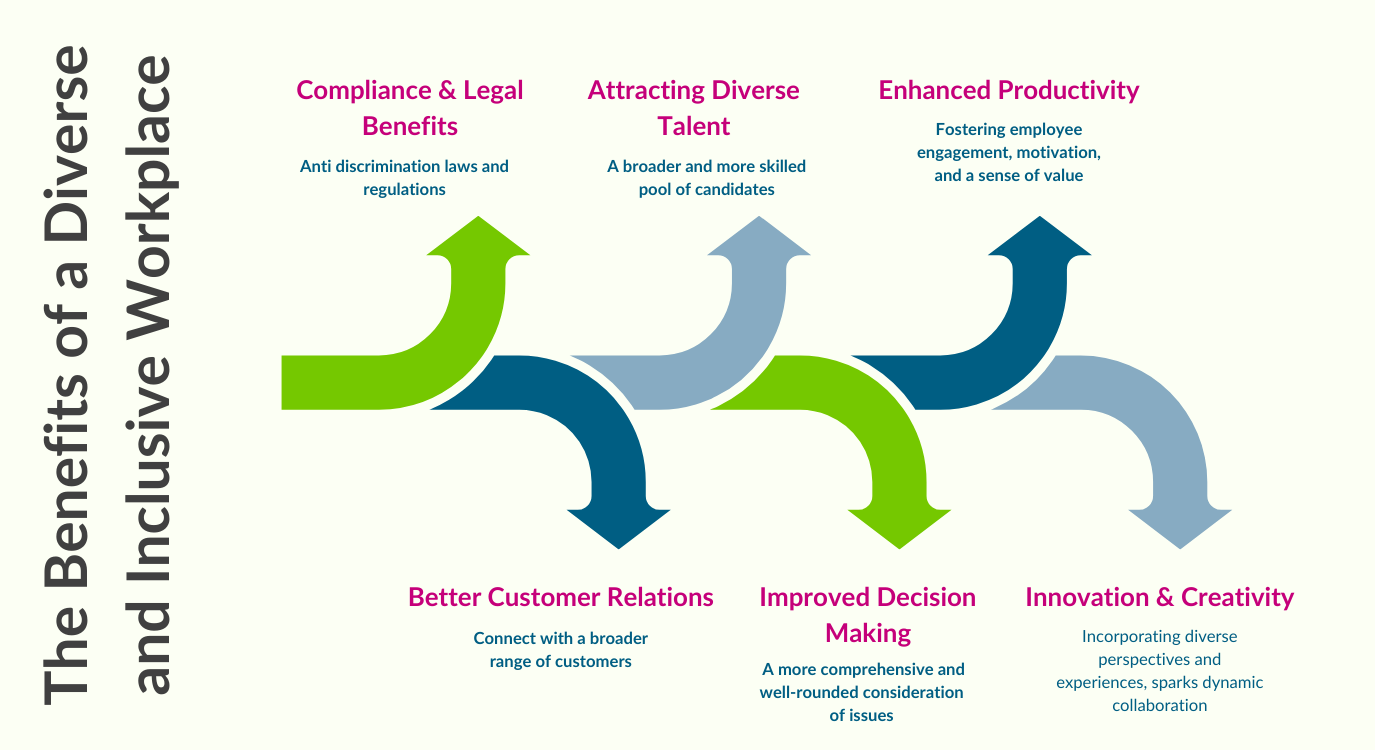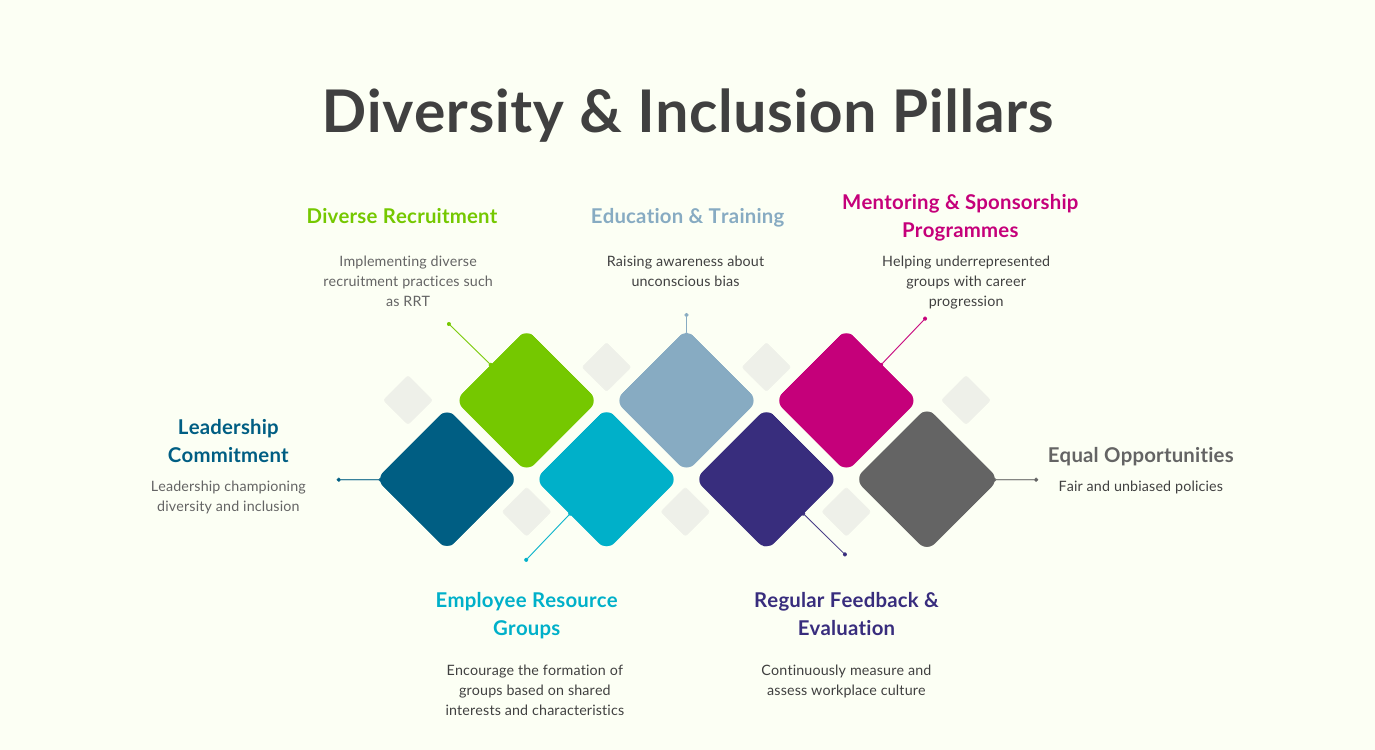
In today’s rapidly evolving world, diversity and inclusion in the workplace have become paramount. Businesses worldwide are acknowledging the benefits of embracing a diverse and inclusive workforce, from creating a more vibrant and innovative workplace culture to attracting diverse talent. In this blog, we’ll delve into the significance of diversity and inclusion in the workplace, highlighting the pivotal role they play in shaping the modern workplace.
Diversity and inclusion are not just buzzwords; they are a fundamental shift in the way we think about organisational culture, talent recruitment, and employee well-being. They are cornerstones of a progressive, fair, and forward-thinking society, fostering environments where everyone, regardless of their background, has an opportunity to thrive and contribute their unique perspectives and skills.
Key Takeaways:
- Importance of Diversity and Inclusion: Embracing diversity and inclusion in the workplace is essential for fostering innovation, productivity, and attracting diverse talent.
- Benefits of a Diverse Workforce: A diverse workforce leads to better decision-making, enhanced creativity, and improved customer relations.
- Workplace Culture: Creating an inclusive workplace culture requires commitment from leadership, diverse recruitment practices, and ongoing education and training.
- Fair Treatment: Ensuring that all employees are treated fairly is fundamental to a diverse and inclusive environment.
- Ongoing Commitment: Promoting diversity and inclusion is an ongoing process that requires continuous effort and a commitment to creating an inclusive culture.
The Changing Face of the Workplace
The workplace landscape has evolved significantly over the years. The traditional, homogenous office environment is giving way to a diverse and inclusive workplace culture, which is a positive shift for both employees and organisations. A diverse workforce includes individuals from various backgrounds, such as age, gender, ethnicity, race, sexual orientation, and more. This diversity is essential to creating an inclusive workplace where everyone feels valued and treated fairly.
The Benefits of a Diverse and Inclusive Workplace

A diverse and inclusive workplace offers numerous advantages that contribute to an organisation’s success. Let’s explore some of the key benefits:
- Innovation and Creativity: A diverse workforce brings a variety of perspectives and experiences to the table, sparking creativity and innovation. Different viewpoints can lead to more effective problem-solving and unique ideas.
- Enhanced Productivity: Employees in an inclusive workplace are more engaged, motivated, and productive. They feel that their contributions matter and are recognised, which drives higher levels of job satisfaction.
- Improved Decision-Making: When a team represents various backgrounds, it leads to better decision-making. Diverse perspectives help in considering all facets of a problem, leading to well-rounded and effective solutions.
- Attracting Diverse Talent: Companies that embrace diversity and inclusion in the workplace are more likely to attract a wider range of talent. Prospective employees seek organisations that foster an inclusive culture.
- Better Customer Relations: A diverse workforce can connect with a broader range of customers. Customers feel more comfortable when interacting with employees who understand their needs and concerns.
- Compliance and Legal Benefits: Promoting diversity and inclusion in the workplace also helps organisations adhere to anti-discrimination laws and regulations, reducing legal risks.
Understanding Workplace Culture
Workplace culture plays a pivotal role in creating a diverse and inclusive environment. It encompasses the shared values, beliefs, and behaviours that shape an organisation. A positive workplace culture promotes the inclusion of individuals from all walks of life, ensuring they feel respected and valued.
To foster a diverse and inclusive workplace culture, organisations need to take several measures:

- Leadership Commitment: Senior leadership must actively champion diversity and inclusion. Their commitment sets the tone for the entire organisation.
- Diverse Recruitment: Implement diverse recruitment practices to attract candidates from various backgrounds. This can include revising job descriptions and reaching out to diverse networks.
- Education and Training: Offer training programmes to raise awareness about unconscious bias and promote inclusive behaviour. Employees should be educated about the benefits of diversity and inclusion.
- Mentoring and Sponsorship Programmes: Establish mentoring and sponsorship programmes to help underrepresented individuals advance in their careers.
- Equal Opportunities: Ensure equal opportunities for everyone within the organisation, irrespective of their background. Fair and unbiased policies are crucial.
- Employee Resource Groups (ERGs): Encourage the formation of ERGs, which provide a supportive community for employees with shared characteristics or interests.
- Regular Feedback and Evaluation: Continuously assess the workplace culture to identify areas that need improvement. Employee feedback is invaluable in this process.
Gender Diversity and Sexual Orientation
Gender diversity and sexual orientation are essential components of a diverse and inclusive workplace. Recognising and respecting the diversity of gender identities and sexual orientations is crucial for fostering an environment where everyone is treated fairly.
Gender Diversity:
Promoting gender diversity means ensuring that individuals of all genders are represented in the workplace. It involves creating an atmosphere where women, men, and individuals who identify as non-binary or transgender are treated equally.

Organisations can promote gender diversity by:
- Implementing gender-neutral hiring practices.
- Offering family-friendly policies, including parental leave.
- Addressing the gender pay gap by ensuring equal pay for equal work.
- Encouraging leadership opportunities for women and marginalised genders.
Sexual Orientation:
Creating an inclusive workplace means respecting and celebrating the sexual orientations of all employees. LGBTQ+ employees should feel safe, welcomed, and supported.
Steps to promote sexual orientation diversity and inclusion include:
- Implementing non-discrimination policies that explicitly protect LGBTQ+ employees.
- Offering diversity and inclusion training that covers LGBTQ+ topics.
- Supporting LGBTQ+ events and awareness initiatives.
- Encouraging open and honest communication about sexual orientation.
Exploring Ethnic Diversity
Ethnic diversity is a vital dimension of a truly inclusive workplace. It encompasses individuals from various racial and cultural backgrounds, contributing to the rich tapestry of experiences within an organisation. Recognising and celebrating ethnic diversity is a key step towards fostering inclusive cultures, forming diverse teams, and creating an environment where different groups with different backgrounds can thrive.
Why Ethnic Diversity Matters:
- Broadened Perspectives: Ethnic diversity brings an array of perspectives and life experiences, enriching decision-making processes and problem-solving within an organisation.
- Global Relevance: In an interconnected world, businesses are increasingly interacting with a global customer base. Having a diverse workforce that reflects different ethnicities helps in understanding and serving a wider range of customer needs.
- Cultural Competence: Employees from various ethnic backgrounds often possess cultural competence, which can be an invaluable asset in cross-cultural collaborations and international business ventures.
- Innovative Solutions: Diverse teams, including those with ethnic diversity, tend to come up with more innovative solutions, as they draw from a wider range of experiences and viewpoints.

Fostering Ethnic Diversity:
- Inclusive Recruitment: Implement inclusive recruitment practices that actively seek candidates from diverse ethnic backgrounds. Avoid biases and assumptions during the hiring process.
- Training and Awareness: Offer diversity and inclusion training to all employees that specifically addresses the importance of ethnic diversity. Create awareness about unconscious bias and stereotypes.
- Support Networks: Encourage the formation of support networks for employees from various ethnic backgrounds. These networks can provide a sense of belonging and facilitate professional development.
Embracing Ethnic Diversity in Diverse Teams:
Diverse teams, including those with ethnic diversity, offer numerous advantages, such as a wider perspective and increased creativity. When different groups from different backgrounds collaborate, it leads to a synergistic exchange of ideas and a more comprehensive understanding of complex issues.
Treated Fairly in a Diverse and Inclusive Environment
One of the cornerstones of a diverse and inclusive workplace is ensuring that all employees are treated fairly, regardless of their background. This involves addressing unconscious biases, promoting equity, and providing equal opportunities.
To ensure that employees are treated fairly in a diverse and inclusive environment, organisations can:
- Provide diversity and inclusion training for all employees to raise awareness about bias and stereotypes.
- Establish clear policies and procedures for addressing discrimination and harassment.
- Promote transparency in hiring, pay, and promotions to prevent bias.
- Celebrate diversity and create a culture where everyone is valued and respected.
Conclusion
The value of diversity and inclusion in the workplace cannot be overstated. It is essential for building a vibrant and innovative workplace culture that benefits both employees and organisations. Embracing a diverse and inclusive workforce not only fosters creativity and productivity but also attracts top talent and strengthens customer relations.
To succeed in today’s dynamic business environment, organisations must prioritise diversity and inclusion in the workplace. By doing so, they create a positive workplace culture that benefits all and paves the way for a brighter, more inclusive future.
Remember that promoting diversity and inclusion is an ongoing process. Organisations must remain committed to these principles and continuously work to create an environment where everyone feels valued and empowered.









